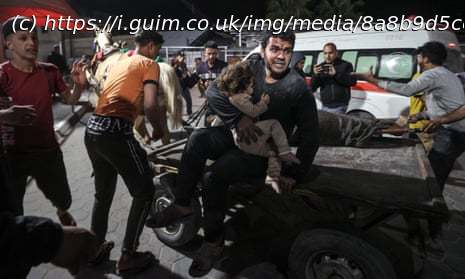In today’s newsletter: Why Benjamin Netanyahu ordered new attacks on dozens of sites in Gaza – and what happens next
Good morning. Just before 2.30am local time, Israel launched airstrikes on dozens of targets across Gaza. War planes hit sites across the territory, from Gaza City in the north to Khan Younis in the south. At least 330 people have been reported dead so far, Gaza’s health ministry said, and Benjamin Netanyahu’s office appeared to suggest that the two-month-old ceasefire is now over: “Israel will, from now on, act against Hamas with increasing military strength,” it said.
You can follow the latest here at the Guardian’s live blog. Today’s newsletter explains what’s happened overnight, and why. Here are the headlines.In depth: ‘They unleashed the fire of hell again on Gaza’
Since the first phase of the ceasefire in Gaza expired in early February, many Palestinians have been braced for a return to war at any time. Instead of moving on to a planned second phase, Israel cut off aid shipments into the territory and pressed Hamas to accept a plan that would extend the first phase and bring the release of more hostages, a move Hamas was unwilling to take without steps towards the complete withdrawal of Israeli troops.
Two days ago, talks in Doha failed again to reach an agreement. One key question now is whether the airstrikes unleashed overnight herald a full-scale return to hostilities, with Israeli ground troops operating in Gaza again and Hamas responding, or are an attempt by Benjamin Netanyahu to force Hamas to accept Israel’s terms – but the very hostile language from Israel suggests that the latter is now unlikely.
Here’s what else we know.
What kind of damage has been done?
The first explosions were heard in north-west Gaza, as many ate their pre-dawn meals during the holy month of Ramadan. The airstrikes hit Gaza City in the north, Deir al-Balah in the centre, and Khan Younis and Rafah in the south. Israel said that it had hit “terror targets belonging to the Hamas terrorist organisation”.
Witnesses and photographs taken at Gaza’s hospitals suggested that many civilians, including children, were among the dead, with piles of bodies stacked up under white plastic sheets. AFP quoted Ramez Alammarin, 25, who described carrying children to a hospital near Gaza City. “They unleashed the fire of hell again on Gaza,” he said. “Bodies and limbs are on the ground, and the wounded cannot find any doctor to treat them. They bombed a building in the area and there are still martyrs and wounded under the rubble … fear and terror. Death is better than life.”
The European hospital in Rafah said that 17 members of one family, including 12 women and children, were killed there. Mahmoud Abu Wafah, Gaza’s deputy interior minister and the highest-ranking Hamas security official in the territory, was reported to be among the dead.
The toll, recently reported at 330, is likely to rise, since it does not include all those taken to smaller health centres or those yet to be found by rescuers.
Is the ceasefire over?
By one very clear measure, yes: while Israel has carried out some drone strikes against suspected militants in recent weeks, the overnight airstrikes are on an entirely different scale.
The statement from Benjamin Netanyahu’s office referring to plans to act with “increasing military strength” also appears to point in a clear direction. And the White House, which was consulted before the new attack, said: “Hamas could have released hostages to extend the ceasefire but instead chose refusal and war.”
Hamas, meanwhile, accused Israel of treachery for overturning the ceasefire, and said that Netanyahu is using the war as a “lifeboat” to ensure his own political survival amid domestic crises.
Start
United States
USA — mix Tuesday briefing: At least 330 dead in major Israeli airstrikes that break...






